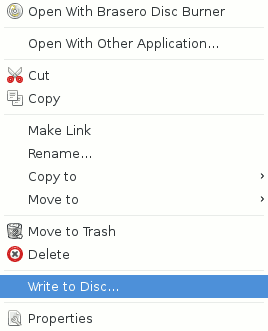Installing an operating system
When you want to install a new operating system, the first thing to do is to get an installer medium, which usually involves two steps: downloading an image, and writing it to a medium. There are two major types of media usable for that purpose: optical discs and USB sticks. There used to be a third one, floppy disks, but it is no longer used, and it was conceptually very similar to USB sticks.
Power-user
If you are a power-user, you probably use USB stick, to be able to reuse them and because they are easier to carry. For you, writing an optical disc or an USB drive is almost the same:
$ wodim image.iso $ dd if=image.img of=/dev/sdc
Regular user
But what would you suggest to a normal user? USB stick? You should not: while it is technically much easier to write an USB stick (just copy blocks from the image to the peripheral file, without any need to use any specific function), desktop file manager make it much harder. Indeed, for a desktop user, burning an ISO image to an optical disk is quite simple: right-click on the image file and choose the “burn” option. But writing an image to an USB stick? There is no similar option, so that will involve calling a power-user friend, which will tell you to open a terminal and type “dd if=…”.

Nautilus's context menu: write to optical disc…
Moral
- Power-users
- Continue using USB sticks as installation media, but tell regular users to use optical discs until desktop file managers adapt.
- Regular users
- Use optical discs. If your computer does not have an optical reader, either invite a power user friend, or buy an USB optical reader.
- Desktop developers
- Please, fix that! Writing an image to an USB stick should not be harder than burning it to an optical disc! People are using more and more computers without an optical reader, and that situation is certainly not new, as it is only similar to that of the time when we were using floppy disks.
8 comments
monday 31 december 2012 à 01:07 mirabilos said : #1
monday 31 december 2012 à 03:51 Hashem said : #2
monday 31 december 2012 à 07:36 tomás zerolo said : #3
monday 31 december 2012 à 09:18 Tanguy said : #4
monday 31 december 2012 à 10:17 Tshirtman said : #5
monday 31 december 2012 à 10:19 Tanguy said : #6
tuesday 01 january 2013 à 03:56 lachlan said : #7
tuesday 08 january 2013 à 18:49 Alan said : #8